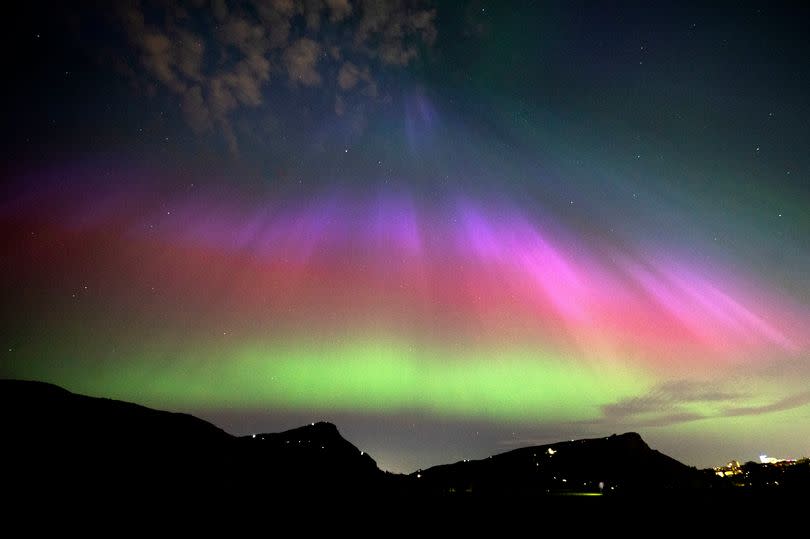Northern lights due now: Exact time to see them in the UK on Saturday, May 11

The Northern Lights are due to be seen again in the UK on Saturday night for the second night in a row, and experts have been explaining the exact time to see them.
App Aurorawatch UK has issued a red alert for tonight meaning that the aurora borealis is set to be visible over much of the UK again. You can see pictures from Friday night here.
And just as on Friday night, the Northern Lights are set to light up the skies all across the UK, meaning you have a chance to see it no matter where you are, especially since the skies are due to be clear.
Usually places away from light pollution with a clear view of the night sky have the best opportunity to see the lights but even that didn't seem to matter on Friday and for Saturday night, the Met Office says there's a good chance of sightings across Scotland, Northern Ireland and parts of northern England and Wales in particular.
What time will the Northern Lights be brightest?
The geomagnetic storm is expected to be in the 'strong' category, though early indications were that it may not reach the 'extreme' of last night. Still, weather conditions are ideal with clear skies.
But it needs to be dark, so you'll need to wait until at least 10.30pm. And, in fact, at this time of year, 11.30pm into the early hours of the morning is when the night is darkest. But different colours will likely be visible in different places at different times.
One scientist revealed that huge explosions in the sun could mean a good show tonight. Prof Mathew Owens said on X: “And as we all collectively take a breath, a reminder there’s a couple more CMEs en route for tonight! Though it’s unlikely to anything like as impressive as last night’s show.”
CMEs (Coronal Mass Ejections) are large expulsions of plasma and magnetic field from the Sun’s corona.
Chris Snell, a meteorologist at the Met Office, said there were sightings “from top to tail across the country”. He said: “It is hard to fully predict what will happen in the Earth’s atmosphere, but there will still be enhanced solar activity tonight, so the lights could be visible again in northern parts of the UK, including Scotland, Northern Ireland and the far north of England.”
Mr Snell said there were sightings in parts of Europe on Friday night as well, with the Met Office receiving pictures and information from locations including Prague and Barcelona. He advised those hoping to see the lights on Saturday to head to an area with low light pollution and to use a good camera, adding: “The best chance you have of seeing the lights is if you are away from street lights and areas with lots of light pollution, as any type of light does have a big effect. Also, at this time of year, we are fighting the shorter length of nights, so it is unlikely that they will be visible until around 10.30pm or 11 o’clock when it gets really dark.”
Why are the Northern Lights so visible in the UK this weekend?
The G5 geomagnetic storm, which is considered extreme and the strongest level of solar storm, hit Earth on Thursday. The cause of this storm was a “large, complex” sunspot cluster, 17 times the diameter of the Earth, according to the NOAA.
The last storm with a G5 rating hit Earth more than 20 years ago in October 2003 and caused power outages in Sweden, Professor Carole Haswell told the BBC Radio 4 Today Programme on Saturday morning.
Prof Haswell, head of astronomy at the Open University, said: “A lot of the satellites communicate using radio signals and all of these charged particles speeding around disrupt radio signals, particularly GPS which is used by planes can be disrupted so it can cause navigation problems, it can cause outages with satellites, it can bring down power systems. The last big G5 storm caused a power outage in Sweden and I haven’t heard of anything happening this time yet, so hopefully people have designed in sort of redundancies into their systems so that they can actually weather this sort of space weather.”
Aurora displays occur when charged particles collide with gases in the Earth’s atmosphere around the magnetic poles. In the northern hemisphere, most of this activity takes place within a band known as the aurora oval, covering latitudes between 60 and 75 degrees. When activity is strong, this expands to cover a greater area – which explains why displays can be occasionally seen as far south as the UK.
How to take the best photo of the Northern Lights
Amateur photographer Anne Wilkie was among those who captured the lights on her iPhone on Friday night. According to the BBC, her tips for getting the best photo include:
Switch off the flash
Set the camera to night mode, and adjust the slider to three to five seconds
Keep the camera as steady as possible or use a tripod

 Yahoo News
Yahoo News 
